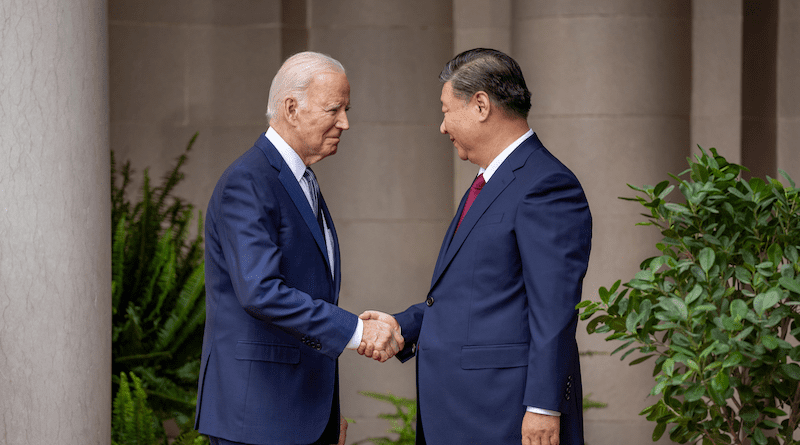Avoiding The Awful Consequences Of Breakdown In The US-China Relationship – OpEd
By EAF editors
The relationship between the United States and China is undoubtedly the most consequential of all relationships for the global order today.
Together, the United States and China account for more than 45 per cent of global output and nearly a quarter of world trade. Despite the diversion of US trade from China because of the trade and technology wars initiated under President Trump — but also prosecuted under President Biden — their economies remain closely linked through trade and international financial ties. Importantly, they have deeply interdependent economic relations with the East Asian economies on which the whole Asia Pacific region’s economic prosperity is built. They have more common interest in cooperation on meeting the global threat of climate change than any other two countries on the planet.
At the same time, these two superpowers are shaping up to an awkward and unstable military-strategic face-off across the Pacific.
In this week’s lead article, David Lampton and Thomas Fingar point out that ‘[no] foreign policy challenge is more important [for the United States], or difficult, than finding a way to simultaneously deter and engage China without provoking unwanted behaviours’. They also acknowledge that ‘… this requires understanding the perceptions and priorities now shaping Beijing’s actions’.
The current dynamic in bilateral relations between the two big powers is dangerous. Leaders on both sides are shoring up their domestic support by demonising the other as an existential threat. China has blundered into aligning with miscreant states like Russia, North Korea and Iran, while the United States has stumbled into a strategy of economic and political containment against China that is driving Beijing further away from it and ‘in the wrong direction’.
The problem, as Lampton and Fingar see it, is that Beijing is now captured by a mindset where domestic and international security imperatives trump development and modernisation imperatives in national policy. This is a syndrome that infects other parts of the world, including the United States, in a way that serves to validate Chinese fears and policy responses.
This dynamic ‘is not good for China, the United States or the world. Washington cannot achieve immediate or fundamental changes in China’s behaviour but ill-considered actions can make things worse’, Lampton and Fingar correctly note.
When internal and external stability are more secure, the gains from interdependence and openness are more likely to be pursued. At this time, when China values national and regime security above growth and is deeply suspicious of foreign interference, domestic-centred economic policies and restrictions on civil society are accompanied by the consolidation of Xi Jinping’s strong-man rule.
No power outside China, not even the United States, has the capacity to turn these deeply structural developments around any time soon.
But what can be done to avoid the catastrophe of conflict between two powers that still have so many mutual interests in common?
The priority in Washington’s strategy, Lampton and Fingar recommend, is to keep the door open to a better day with China through continuing to engage in a way that underlines that prospect, while effectively deterring behaviour detrimental to the strategic interests of the United States and its Asian allies and partners.
The United States should adopt policies that make clear that ‘it hopes for the material progress of China in a cooperative framework’, say Lampton and Fingar, and make absolutely clear ‘that it will support any resolution of cross-Strait relations peacefully agreed to by the people on both sides of the Taiwan Strait’.
The question is whether, against all the forces now aligned against it in US politics, including the possible re-election of Donald Trump in November this year, that objective can be articulated in US–China strategies in a way that can make a difference to outcomes.
For the rest of the world, including US partners like Japan, South Korea, the ASEAN countries, Australia and New Zealand in Asia and the Pacific, much hangs on getting a joint script right.
US–China tensions pose stark choices for the heavily economically integrated and internationally exposed states of East Asia. They are choices that put significant pressure on the region because of the variegated structure of its political and security ties with the United States and the nature of China’s new power. They are pressures that have the potential to drive large wedges, for example, among ASEAN members as well as between ASEAN and its dialogue partners in the ASEAN+6 group and the ASEAN+8 (East Asia Summit) processes, and inflict unrecoverable damage upon the East Asia integration enterprise.
Those countries need urgently to work with the United States and China in bringing their stability to the relationship. The enunciation of the principles and the norms that will ensure a measure of political stability between the two big powers in the region are not merely the province of the two powers themselves, but are matters on which the rest of the region also has significant purchase.
That requires ramping up an altogether harder-edged region-wide diplomacy that reinforces the appeal for Washington and Beijing to maintain the bedrock understandings that can deliver a stable US–China relationship even in these challenging times: acceptance of each others’ political systems and sovereignty; a commitment to the One China policy and peaceful management of the Taiwan question; economic, scientific and regional engagement; and military-to-military level communication and transparency.
Taking every opportunity over the coming months — well before the US presidential elections in November — to push these interests in bilateral and regional diplomacy and frame them as principles that are expected in the conduct of all powers, large and small, is an urgent regional foreign policy task.
- This article was published by East Asia Forum

